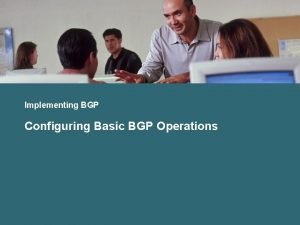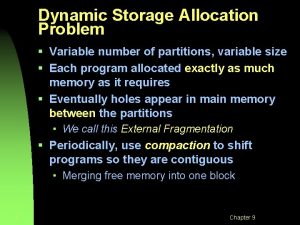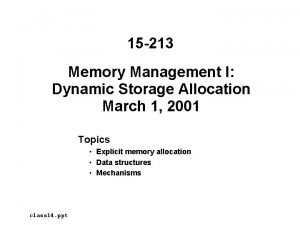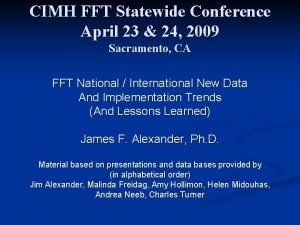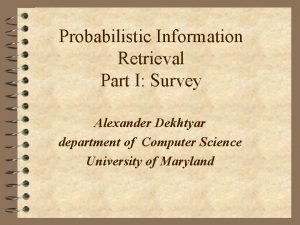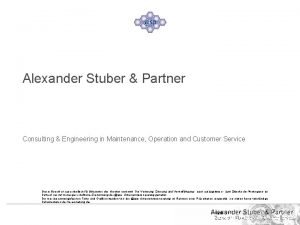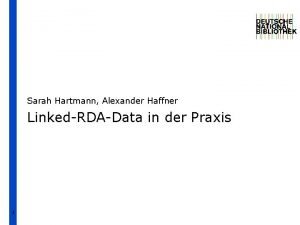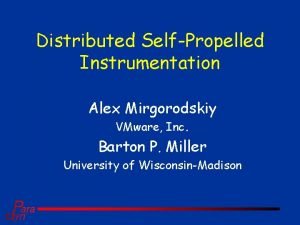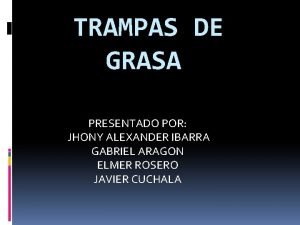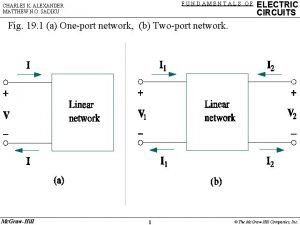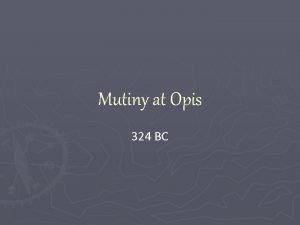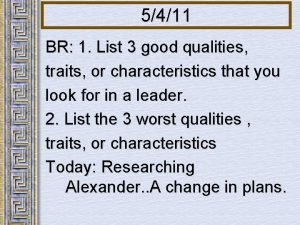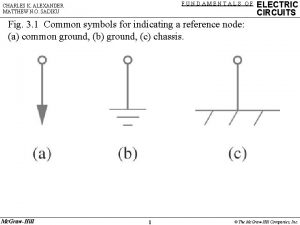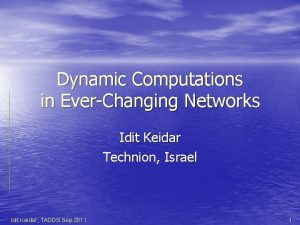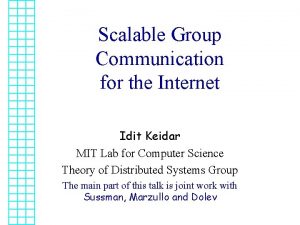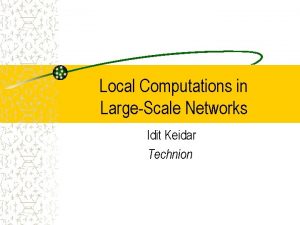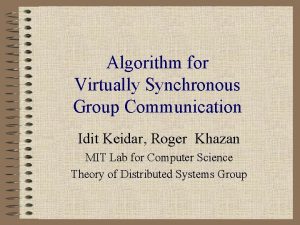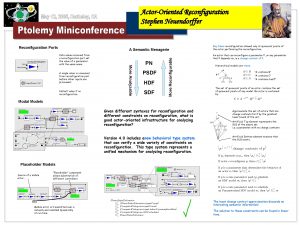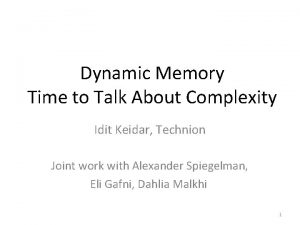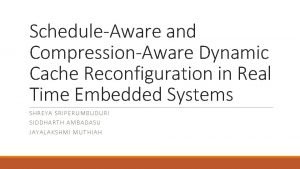Dynamic Storage Reconfiguration Alexander Spiegelman Idit Keidar Agenda


































































































- Slides: 98

Dynamic Storage Reconfiguration Alexander Spiegelman, Idit Keidar

Agenda • Reconfigurable atomic storage – Motivation – Definition • Solutions – Expired configuration oracle – Traversing possible configurations – Using a generic Sp. Sn abstraction – Existing algorithms as Sp. Sn implementations

Distributed Shared Storage server client • Reliable replicated storage • Using unreliable components • Asynchrony - tolerate unpredictable network delays 3

Distributed Shared Storage 101 • Servers – fault-prone • Clients – ephemeral, infinitely many • Servers emulate read/write registers to clients – ABD [Attiya, Bar-Noy and Dolev] read/write 1 2 3 4 5

ABD Register Emulation Write to majority 1 2 3 4 5

ABD Register Emulation 1 2 3 4 5

ABD Register Emulation Read from majority 1 2 3 4 5

ABD Register Emulation 1 2 3 4 Every two majorities intersect 5

Motivation for Reconfiguration • ABD tolerates minority failures 1 2 3 4 5 • No more failures are allowed! – need to be able to remove faulty and add correct servers

But, Be Careful! Remove(1, 2) Add(6, 7) 1 2 3 4 Remove(1, 2) Add(8, 9) 5

But, Be Careful! 6 7 4 3 5 8 9

But, Be Careful! Split Brain! 6 7 4 3 5 • Client have to coordinate 8 9

Agenda • Reconfigurable atomic storage – Motivation – Definition • Solutions – Expired configuration oracle – Traversing possible configurations – Using a generic Sp. Sn abstraction – Existing algorithms as Sp. Sn implementations • Liveness with endless reconfigurations

Model • Infinite set of clientsΠ – any client can fail by crashing • Infinite set of potential servers Φ – failures are restricted – generalize majority to dynamic model (soon) • Communication – asynchronous

Configuration • Finite set of servers & history how we got to it • Changes = {+, -} XΦ – E. g. , change can be +s 12 or –s 7 • Configuration = finite subset of Changes – e. g. , {+s 1, +s 2, -s 2 +s 3, -s 4, +s 12} • Initial configuration C 0 is known to all clients – e. g. , {+s 1, +s 2, +s 3, +s 4, +s 5}

Configuration’s Membership • Servers that were added and not removed – i. e. , {s | +s ∈ conf ∧ -s ∉ conf } – e. g. , Initial membership is {s 1, s 2, s 3, s 4, s 5} – by slight abuse of notation, we sometimes refer to C. membership as C configuration C C. membership +s 1 +S 3 +s 5 - s 2 +s 4 - s 5 S 3 s 4

Install event • Configurations can be installed – i. e. , install(C 0) – Intuitively, indicates that from now on we expect to be able to perform operations in the new configuration • We will use it to define the failure model

Changing the Configuration • Add reconfig(C, P) to the API – Changes configuration C by applying changes in P – Returns new installed configuration C’ – May install more configurations – C becomes superseded • C is either C 0 or a configuration returned by an earlier reconfig (assumption on usage) • Proposal P is a set of changes – E. g. , {+s 12, -s 7, -s 2} • By convention, reconfig({}, C 0) returns C 0 at time 0

Changing the Configuration (sequential example) C 0 reconfig(C 0, {+s 4, -s 1+}) installed +s 1 +s 2 +S 3 When reconfig returns C 1, C 0 is superseded C 1 +s 1 - s 1 +s 2 +s 4 +S 3

Reconfiguration Properties • reconfig(C, P) returns C’ s. t. – C’ was installed – C’ reflects P: C’ C P – Validity: if C’’ was installed, then for every c in C’’ there was reconfig(*, P’’) invocation s. t. c ∈ P’’

Reconfiguration Properties +s 1 • For example consider reconfig(C 0, {+s 4}) +s 2 – Concurrent with reconfig(C 0, {+s 5, - s 1}), C 1 +s 1 C 2 C 0 +S 3 C 4 +s 1 +s 4 +s 2 - s 1 +s 2 +s 5 +S 3 - s 1 +s 4 +S 3 • Both operations can install • reconfig(C 0, {+s 4}) can return all

Failure Model • For ABD, need live majority – but in which configuration? • Availability: A configuration C is available if a majority of C. members is alive – Rationale: can emulate register using ABD • We require reconfigurability: – Every installed configuration C must be available until it superseded (a reconfig returns C’ ⊂ C) – Rationale: Administrator may take down machines once a reconfiguration removing them returns

Shared Memory Abstraction • We can see each configuration as a collection of (low-level) MWMR registers • emulated by the servers in the configuration’s membership (ABD) • accessible by clients if the configuration is available • all the registers can be read in one access c c X. read() Y. write(v) s s s

Problem: Dynamic Storage • Emulate MWMR register • Using a dynamic set of servers • May fail subject to reconfigurability • Clients invoke operations – read(), write(v), and reconfig(C, P) – sequential read/write specification: a read returns the last written value – reconfig(C, P) returns C’ that is installed, reflects P, and satisfies validity

Agenda • Reconfigurable atomic storage – Motivation – Definition • Solutions – Expired configuration oracle – Traversing possible configurations – Using a generic Sp. Sn abstraction – Existing algorithms as Sp. Sn implementations

Tracking Available Configurations C 0 +s 1 +s 2 +S 3

Tracking Available Configurations C 0 +s 1 +s 2 +S 3 C’ reconfig +s 4, +s 5 +s 1 +s 4 +s 2 +s 5 +S 3

Tracking Available Configurations C 0 +s 1 +s 2 C’ reconfig +s 4, +s 5 C’ client We need to help clients +s 4 +s 2 +s 5 +S 3 May be unavailable (reconfigurability) +s 1

Expired Configuration Oracle • Necessary for liveness • Distributed • Notified of superseded configurations – Using expire(config, next) event • Informs clients of next configurations

Tracking Available Configurations C 0 +s 1 +s 2 +S 3 C’ reconfig +s 4, +s 5 Expire(C 0, C 1) May be unavailable (reconfigurability) C’ client +s 1 +s 4 +s 2 +s 5 +S 3

Expire: A Closer Look • Client invokes expire(config, next) – config is expired, next is newer • Different clients may expire the same configuration with different nexts • A client that accesses an unavailable configuration – May either succeed OR – Receive an expired message with some next configuration OR – Stuck forever if the configuration was not previously expired

Expire Event c 1 C 0

Expire Event Reconfig(C 0, P 1) c 1 C 0

Expire Event Reconfig(C 0, P 1) Install(C 1) c 1 C 1=C 0∪P 1 C 0

Expire Event expi re(C 0, C 1 ) Reconfig(C 0, P 1) Install(C 1) expire(C 0, C 1) c 1 C 1=C 0∪P 1 C 0

Expire Event Reconfig(C 0, P 2) Reconfig(C 0, P 1) Install(C 1) expire(C 0, C 1) c 2 c 1 C 1=C 0∪P 1 C 0

Expire Event Reconfig(C 0, P 2) Install(C 2) Reconfig(C 0, P 1) Install(C 1) expire(C 0, C 1) c 2 c 1 C 1=C 0∪P 1 C 0 C 2=C 0∪P 2

Expire Event exp ire( C 0 , C 2 ) Reconfig(C 0, P 2) Install(C 2) expire(C 0, C 2) Reconfig(C 0, P 1) Install(C 1) expire(C 0, C 1) c 2 c 1 C 1=C 0∪P 1 C 0 C 2=C 0∪P 2

Expire Event C 1 C 2 c 3 c 4 Reconfig(C 0, P 2) Install(C 2) expire(C 0, C 2) Reconfig(C 0, P 1) Install(C 1) expire(C 0, C 1) c 2 c 1 C 1=C 0∪P 1 C 0 Expire is dangerous! C 2=C 0∪P 2 Unavailable Clients must coordinate.

Agenda • Reconfigurable atomic storage – Motivation – Definition • Solutions – Install/expire oracle – Traversing possible configurations – Using a generic Sp. Sn abstraction – Existing algorithms as Sp. Sn implementations

Dynamic Atomic Storage Read/Write Naïve Solution • When there is no reconfig in progress, emulate read/write using ABD on latest configuration returned by reconfig • What happens during reconfiguration? Tomorrow Technion servers will be down for maintenance from 5: 30 am to 6: 45 am Virtually Yours, Moshe Barak

We Don’t Want to Stop the World • Where do we read/write during reconfiguration? • Track installed non-superseded configurations – Read in all – Write in the latest • How we do it? • What about reconfig?

Consensus Can Help With Reconfig • Rambo – uses consensus to agree on the next conf C 0

Consensus Can Help With Reconfig • Rambo – uses consensus to agree on the next conf – Reconfig: C 0

Consensus Can Help With Reconfig • Rambo – uses consensus to agree on the next conf – Reconfig: Propose(P 1) c 1 C 0 Propose(P 2) c 2

Consensus Can Help With Reconfig • Rambo – uses consensus to agree on the next conf – Reconfig: c 1 C 0 Decide(P’) c 2

Consensus Can Help With Reconfig • Rambo – uses consensus to agree on the next conf – Reconfig: Install(C 1) expire(C 0, C 1) c 1 C 0 Decide(P’) c 2 C 1=C 0∪P’

Consensus Can Help With Reconfig • Rambo – uses consensus to agree on the next conf – Reconfig: Install(C 1) expire(C 0, C 1) c 1 C 0 Decide(P’) c 2 C 1=C 0∪P’ C 2

Traversing Configuration DAG • Asynchronous solutions traverse DAG – Dyna. Store [Aguilera, Keidar, Malkhi and Shraer] – Smart. Merge[Jehl, Vitenberg and Meling] – Parsimonious Sp. Sn [Gafni and Malkhi]

Traversing Configuration DAG

Traversing Configuration DAG C 1 C 2 C 3 Clients install the configurations they propose.

Traversing Configuration DAG C 1 C 2 C 3 Then, propose them in the initial configuration,

Traversing Configuration DAG C 1, C 3 C 2, C 3 C 1 C 2 C 3 and learn what configurations were proposed

Traversing Configuration DAG C 1, C 3 C 2, C 3 C 1 C 2 C 3 Continue the traverse to all the learned configurations. • In each configuration a client proposes the union of all the configurations it traversed so far

Traversing Configuration DAG C 1, C 3 C 2, C 3 C 1 C 2 C 3 For correctness, must ensure traversal intersection

Traversing Configuration DAG C 1, C 3 C 2, C 3 C 1 C 2 C 3

Traversing Configuration DAG C 1, C 3 C 2, C 3 Orange accesses C 1: Proposes (and installs) C 1∪C 3 Learns C 1∪C 3 C 1 C 2 C 3

Traversing Configuration DAG C 1, C 3 C 2, C 3 C 1∪C 3 C 2∪C 3 Green accesses C 2: Proposes (and installs) C 2∪C 3 Learns C 2∪C 3 C 1∪C 3 C 2∪C 3

Traversing Configuration DAG C 1, C 3 C 2, C 3 C 1∪C 3 C 2∪C 3 Green accesses C 3: Proposes C 2∪C 3 Learns C 2∪C 3 C 1∪C 3 C 2∪C 3

Traversing Configuration DAG C 1, C 3 C 2, C 3 C 1∪C 3 C 2∪C 3 Orange accesses C 3: Proposes C 1∪C 3 Learns C 2∪C 3, C 1∪C 3 C 2∪C 3

Traversing Configuration DAG C 1, C 3 C 2, C 3 C 1∪C 3 C 2∪C 3 Red accesses C 3: Proposes C 3 Learns C 2∪C 3, C 1∪C 3 C 2∪C 3

Traversing Configuration DAG C 1, C 3 C 2, C 3 C 1∪C 3 C 2∪C 3 C 1∪ C 2∪C 3 Red accesses C 1∪C 3: Proposes C 1∪ C 2∪ C 3 Learns. C 1∪ C 2∪ C 3 C 1∪C 3 C 2∪C 3 C 1∪ C 2∪C 3

Traversing Configuration DAG C 1, C 3 C 2, C 3 C 1∪C 3 C 2∪C 3 C 1∪ C 2∪C 3 Orange accesses C 1∪C 3: Proposes C 1∪C 2∪C 3 Learns C 1∪C 2∪C 3 C 1∪C 3 C 2∪C 3 C 1∪ C 2∪C 3

Traversing Configuration DAG C 1, C 3 C 2, C 3 C 1∪C 3 C 2∪C 3 C 1∪ C 2∪C 3 Orange accesses C 2∪C 3: Proposes C 1∪C 2∪C 3 Learns C 1∪C 2∪C 3 C 1∪C 3 C 2∪C 3 C 1∪ C 2∪C 3

Traversing Configuration DAG C 1, C 3 C 2, C 3 C 1∪C 3 C 2∪C 3 C 1∪ C 2∪C 3 Red accesses C 2∪C 3: Proposes C 1∪C 2∪C 3 Learns C 1∪C 2∪C 3 C 1∪C 3 C 2∪C 3 C 1∪ C 2∪C 3 C 1� C 3 C 2� C 3 C 1� C 2� C 3

Traversing Configuration DAG C 1, C 3 C 2, C 3 C 1∪C 3 C 2∪C 3 C 1∪ C 2∪C 3 Green accesses C 2∪C 3: Propose C 2∪ C 3 Learns C 1∪ C 2∪ C 3 C 1∪C 3 C 2∪C 3 C 1∪ C 2∪C 3

Traversing Configuration DAG C 1, C 3 C 2, C 3 C 1∪C 3 C 2∪C 3 C 1∪ C 2∪C 3 Orange accesses C 1∪C 2∪C 3 : Proposes C 1∪C 2∪C 3 Learns C 1∪C 2∪C 3 No more configurations: Returns C 1∪C 2∪C 3 C 1∪C 3 C 2∪C 3 C 1∪ C 2∪C 3

Traversing Configuration DAG C 1, C 3 C 2, C 3 C 1∪C 3 C 2∪C 3 C 1∪ C 2∪C 3 Green accesses C 1∪C 2∪C 3 : Proposes C 1∪C 2∪C 3 Learns C 1∪C 2∪C 3 No more configurations: Returns C 1∪C 2∪C 3 C 1∪C 3 C 2∪C 3 C 1∪ C 2∪C 3

Traversing Configuration DAG C 1, C 3 C 2, C 3 C 1∪C 3 C 2∪C 3 C 1∪ C 2∪C 3 Red accesses C 1∪C 2∪C 3 : Proposes C 1∪C 2∪C 3 Learns C 1∪C 2∪C 3 No more configurations: Returns C 1∪C 2∪C 3 C 1∪C 3 C 2∪C 3 C 1∪ C 2∪C 3

Traversing Configuration DAG C 1, C 3 C 2, C 3 C 1∪C 3 C 2∪C 3 C 1∪ C 2∪C 3 Before returning, clients expire all configuration in their Dag with the last one C 1∪C 3 C 2∪C 3 C 1∪ C 2∪C 3

Traversing Configuration DAG C 1, C 3 C 2, C 3 C 1∪C 3 C 2∪C 3 C 1∪C 3 Orange DAG C 2∪C 3 C 1∪C 3 C 2∪C 3 C 1∪ C 2∪C 3

Traversing Configuration DAG C 1, C 3 C 2, C 3 C 1∪C 3 C 2∪C 3 C 1∪C 3 Green DAG C 2∪C 3 C 1∪C 3 C 2∪C 3 C 1∪ C 2∪C 3

Traversing Configuration DAG C 1, C 3 C 2, C 3 C 1∪C 3 C 2∪C 3 C 1∪C 3 Red DAG C 2∪C 3 C 1∪C 3 C 2∪C 3 C 1∪C 2∪C 3

Traversing Configuration DAG C 1, C 3 C 2, C 3 C 1∪C 3 C 2∪C 3 C 1∪ C 2∪C 3 C 1∪C 3 C 2∪C 3 All DAGs must intersect in every level C 1∪C 2∪C 3

Recall: No agreement • Clients may return different configurations in the intersection path C 1∪C 3 C 2∪C 3 C 1∪C 2∪C 3

Recall: No agreement • Clients may return different configurations in the intersection path • For example: C 1∪C 3 C 2∪C 3 C 1, C 3 C 2, C 3 C 1∪C 3 C 2∪C 3 Red accesses 3: Proposes C 3 Learns C 3 No more configurations: Returns C 3

But, Lattice Agreement • Configurations in the same path in the DAG are related by containment C 1∪C 3 C 2∪C 3 C 1∪C 2∪C 3

(Simple) Lattice Agreement • Each process starts with an initial value and learns values that satisfies the following: – Validity: A value learnt by a process is a union of some set of initial values that includes its own initial value. – Consistency: Values learnt by any two processes related by containment. – Stability. A process can learn at most one value.

Agenda • Reconfigurable atomic storage – Motivation and definition – Failure model • Solutions – Expired configuration oracle – Traversing possible configurations – Using a generic Sp. Sn abstraction – Existing algorithms as Sp. Sn implementations

Sp. Sn Abstraction • The core task clients solve in every configuration – A multi-input, multi-output function • Uses ABD to implement a collection of registers • Usage: call Sp. Sn in each configuration to obtain next configuration to traverse Sp. Sn ABD Sp. Sn

Sp. Sn API and Guarantees • Participants input their proposals • The outputs are sets of subsets of proposals • Intersection: One subset appears in all outputs – for example: {{A}} {{A}, {A, B}, {A, B, C}} {{A}, {A, C}, {A, B, C}} {{A}, {B}} {{A}, {B}, {C}}

Generic Traverse Using Sp. Sn • Start with: – speculation = { current } – P= proposal • track every configuration C in speculation: – propose P to C. Sp. Sn – add the output to speculation – P speculation union • if C expired by next – speculation = {next} Jump forward • finally – for every C in speculation , expire(C, P)

Great! But How To Build An Atomic Register? • All operations traverse the DAG – They are very similar • reconfig transfers the latest written value to the last configuration before expiring the configurations in the DAG • read/write help reconfig to unite the DAG, read from every configuration in the DAG and write to the last one

Great! But How To Build An Atomic Register? • Start with: – speculation = { current } – P= proposal • track every configuration C in speculation: – propose P to C. Sp. Sn – add the output to speculation – P speculation union • if C expired by next – speculation = {next} Same in all operations • finally – for every C in speculation , expire(C, final proposal)

reconfig(proposal) • Start with: – speculation = { current } – P= proposal – <v, ts> = < , 0> • track every configuration C in speculation: – speculation = speculation ∪ C. Sp. Sn(P) – <v’, ts’> C. read() – if ts’ > ts, then <v, ts> <v’, ts’> – if C is the last not tracked in speculation • C. write(<v, ts>) • speculation = speculation ∪ C. Sp. Sn(P) – P speculation union • For every C in speculation expire(C, P), and Return P

read() • Start with: – speculation = { current } – P= – <v, ts> = < , 0> • track every configuration C in speculation: – speculation = speculation ∪ C. Sp. Sn(P) – <v’, ts’> C. read() – if ts’ > ts, then <v, ts> <v’, ts’> – if C is the last not tracked in speculation • C. write(<v, ts>) • speculation = speculation ∪ C. Sp. Sn(P) – P speculation union • Return v

write(value) • Start with: – speculation = { current } – P= – <v, ts> = < , 0> • track every configuration C in speculation: – speculation = speculation ∪ C. Sp. Sn(P) – <v’, ts’> C. read() – if ts’ > ts, then <v, ts> <v’, ts’> – if C is the last not tracked in speculation • C. write(<value, ts+1>) • speculation = speculation ∪ C. Sp. Sn(P) – P speculation union • Return ok

Agenda • Reconfigurable atomic storage – Motivation and definition – Failure model • Solutions – Expired configuration oracle – Traversing possible configurations – Using a generic Sp. Sn abstraction – Existing algorithms as Sp. Sn implementations

Recasting Dynamic Algorithms in Terms of Sp. Sn Implementation • We can extract each algorithm’s mechanism to implement Sp. Sn • Implementation differ in the complexity cost and the size of the obtained DAG. – We measure complexity in the number w/r accesses – The DAG size depends on the number of concurrent reconfig and w/r operations.

Dynamic Algorithms in Terms of Sp. Sn For m concurrent clients, n of which perform reconfigurations Algorithm Sp. Sn Implementation DAG size Sp. Sn Cost RAMBO if (proposal != null) write consensus(proposal) return collect n Consensus Dyna. Store if (proposal != null) write proposal return weak snapshot collect min(m 2, 2 n) O(1) collects Smart. Merge Pre-computation: assumes prop lattice. Agreement(proposal) lattice. Agreement never fails (not Sp. Sn: same as Dyna. Store reconfigurable) n O(1) collects Parsimonious Sp. Sn n O(n) collects multi-round commit –adopt

Dyna. Store Uses Weak Snapshot • Array of registers - one for each client • Each client 1. If proposal !=null, write proposal to its register P

Dyna. Store Uses Weak Snapshot • Array of registers - one for each client • Each client 1. If proposal !=null, write proposal to its register 2. collects all the registers 3. If collect is not empty, collect again All clients that return non-empty set see the first written proposal P P One proposal appears in all outputs

Dyna. Store Uses Weak Snapshot • Cost: 3 operations – One write and two collects • DAG size: – 2 n possible subsets of proposals (power set) that can be installed – Each client installs at most n configurations – Therefore: • min(m 2, 2 n)

Smart. Merge Uses Lattice Agreement • Assumes lattice Agreement never fails (not reconfigurable) • Clients first propose in lattice Agreement and then continue with the output as Dyna. Store • Recall – Validity: A value learnt by a process is a union of some set of initial values that includes its own initial value. – Consistency: Values learnt by any two processes related by containment.

Smart. Merge Uses Lattice Agreement • Cost: O(n) – Generalized lattice agreement [Rajamani, Rajan, Ramalingam and Vaswani] • Dag size • The output of lattice agreement is related by containment • Therefore, the size of the power set is bounded by n – At most n possible installed configurations • Thus, the DAG size is at most n

Parsimonious Sp. Sn • Use multiple rounds of commit-adopt – Each round O(1) operations – At least n round – Complexity: O(n) • All the returned subset are related by containment – Therefore, the DAG size is at most n • Reconfigurable – I will skip the details

Dynamic Atomic Storage: Conclusion • Reconfiguration is essential for system longevity • Definition as shared memory object – Read/write/reconfig operations • Failure model: reconfigurability – Configuration remains available until superseded • Generic implementation – Install new configurations – Traverse all installed non-superseded configurations in read/write/reconfig operations – Use Sp. Sn abstraction – Different solutions implement Sp. Sn in different ways

Thank You
 Alexander spiegelman
Alexander spiegelman Alexander spiegelman
Alexander spiegelman Rrc connection reconfiguration
Rrc connection reconfiguration Rrc connection reconfiguration
Rrc connection reconfiguration Sh ip bgp summary
Sh ip bgp summary Soft-reconfiguration inbound
Soft-reconfiguration inbound Agenda sistemica y agenda institucional
Agenda sistemica y agenda institucional Mala spiegelman
Mala spiegelman Art spiegelman biography
Art spiegelman biography Donna spiegelman
Donna spiegelman Motonowa
Motonowa When was art spiegelman born
When was art spiegelman born Maus chapter 4 summary
Maus chapter 4 summary Spiegelman kísérlete
Spiegelman kísérlete Maus chapter 6 summary
Maus chapter 6 summary Unified storage vs traditional storage
Unified storage vs traditional storage Secondary storage vs primary storage
Secondary storage vs primary storage Secondary storage vs primary storage
Secondary storage vs primary storage Uses rigid metallic platters
Uses rigid metallic platters What is dynamic storage allocation problem in os
What is dynamic storage allocation problem in os Dynamic storage allocation
Dynamic storage allocation Transferered
Transferered Alex kolesnik
Alex kolesnik Alexander chance browning
Alexander chance browning Hamilton financial
Hamilton financial Alexander graham bell
Alexander graham bell Alexander confused
Alexander confused Richard brennan alexander technique
Richard brennan alexander technique Alexander premet
Alexander premet Alexander masser
Alexander masser Nicole alexander md
Nicole alexander md Contoso presentation
Contoso presentation Alexander hamilton
Alexander hamilton Where was alexander graham bell telephone invented
Where was alexander graham bell telephone invented Alexander calder medusa
Alexander calder medusa Jim alexander fft
Jim alexander fft Alexander empire split
Alexander empire split Reight
Reight Alexander pushkin
Alexander pushkin Medienkompetenz
Medienkompetenz Alexander j. a. m. van deursen
Alexander j. a. m. van deursen Etymology of alexander
Etymology of alexander Alexander averin peintre
Alexander averin peintre Eba quater
Eba quater Alexander dekhtyar
Alexander dekhtyar Plato teacher of
Plato teacher of Alexander graham bell
Alexander graham bell Alexander von humboldt
Alexander von humboldt Orbis non sufficit
Orbis non sufficit Coriyon alexander
Coriyon alexander How many generals divided alexander's empire?
How many generals divided alexander's empire? Alexander's empire
Alexander's empire Alexander fleming
Alexander fleming Rationalisierungsmaßnahmen
Rationalisierungsmaßnahmen Sir william alexander smith
Sir william alexander smith Alexander coral
Alexander coral Salicylsäuremethylester verseifung
Salicylsäuremethylester verseifung Alexander nikolsky
Alexander nikolsky Alexander dobson
Alexander dobson Program geliştirme modelleri
Program geliştirme modelleri Alexander calder stabile-mobile
Alexander calder stabile-mobile Alexander gottberg
Alexander gottberg Alexander sannik
Alexander sannik Alexander ororbia
Alexander ororbia Alexandru ioan cuza
Alexandru ioan cuza Mieszkanie kubusia puchatka krzyżówka
Mieszkanie kubusia puchatka krzyżówka Petra bendel
Petra bendel Alexander stuber
Alexander stuber Alex colbourn
Alex colbourn Alexander milne
Alexander milne Sarah hartmann berlin
Sarah hartmann berlin Wade alexander phipps
Wade alexander phipps Alexander mirgorodskiy (mirg)
Alexander mirgorodskiy (mirg) Alexander's empire
Alexander's empire Alexander reinert
Alexander reinert Alexander mackenzie
Alexander mackenzie Alexander de grote kaart
Alexander de grote kaart Trampa de grasas durman
Trampa de grasas durman How many continents did alexander’s empire reach?
How many continents did alexander’s empire reach? Prima.declinazione latino
Prima.declinazione latino Alexander the great mutiny
Alexander the great mutiny Alexander
Alexander Reign alexander the great
Reign alexander the great Alexander
Alexander Opis mutiny meaning
Opis mutiny meaning Jonathan alexander abt
Jonathan alexander abt Alexander settles
Alexander settles Alexander jürges
Alexander jürges Alexander shneider
Alexander shneider Alexander the great character traits
Alexander the great character traits Gappi masa
Gappi masa Henry alexander murray
Henry alexander murray Alexander friedmann and george lemaitre
Alexander friedmann and george lemaitre Kongressbirne
Kongressbirne Alexander
Alexander Alexander gardner
Alexander gardner Grekiska kolonier
Grekiska kolonier A sharpshooter's last sleep
A sharpshooter's last sleep Alexander pope the rape of the lock
Alexander pope the rape of the lock




